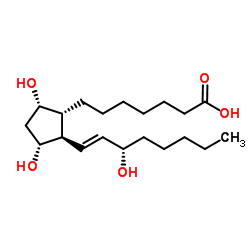Long-term fenofibrate treatment impairs endothelium-dependent dilation to acetylcholine by altering the cyclooxygenase pathway.
Javier Blanco-Rivero, Iván Márquez-Rodas, Fabiano E Xavier, Rosa Aras-López, Irene Arroyo-Villa, Mercedes Ferrer, Gloria Balfagón
Index: Cardiovasc. Res. 75(2) , 398-407, (2007)
Full Text: HTML
Abstract
Experimental studies and opinion articles emphasize that cardiovascular alterations associated with ageing can be improved by the long-term use of fenofibrates. We analyzed the effect of fenofibrate treatment on the acetylcholine-induced relaxation in rat aorta and the participation of nitric oxide (NO) and cyclooxygenase (COX)-derived factors in this effect.Acetylcholine relaxation in untreated and 6-week fenofibrate-treated Wistar rats was analyzed in the absence and presence of the NO synthase (NOS) inhibitor N(G)-nitro-L-arginine methyl ester (L-NAME), the specific inducible NO (iNOS) synthase inhibitor 1400W, the nonspecific COX inhibitor indomethacin, the specific COX-2 inhibitor NS-398, the specific thromboxane receptor antagonist SQ-29548, the thromboxane synthesis inhibitor furegrelate, the prostacyclin synthesis inhibitor tranylcypromine, or the 20-HETES synthesis inhibitor formamidine. eNOS, iNOS, COX-1, and COX-2 expression was studied by Western blotting. In addition, production of prostaglandin F(2alpha) (PGF(2alpha)), thromboxane A(2) (TxA(2)), prostaglandin E(2) (PGE(2)), isoprostanes, and prostacyclin (PGI(2)) was also measured.Fenofibrate treatment reduced acetylcholine relaxation. Indomethacin, NS-398, and tranylcypromine decreased acetylcholine relaxation in untreated rats but enhanced relaxation in treated rats. SQ-29548 increased acetylcholine responses in segments from treated rats but not in segments from untreated rats. L-NAME decreased vasodilator response to acetylcholine in both groups while furegrelate, NS-398, 1400W, and formamidine did not affect acetylcholine responses in either group. eNOS and COX-2 expression was higher in aorta from treated rats while COX-1 and iNOS remained unmodified. Basal and acetylcholine-stimulated NO and PGE(2) release were increased, and that of PGI(2) decreased in treated rats. TxA(2) release was similar, but PGF(2alpha) release was undetectable in both groups.Although it increases NO production through increases in eNOS expression, fenofibrate treatment induces endothelial dysfunction. This effect seems to be mediated by decreased PGI(2) and increased PGE(2) release, and it may help to explain the rise in thromboembolic events observed after long-term fenofibrate treatment in humans.
Related Compounds
| Structure | Name/CAS No. | Molecular Formula | Articles |
|---|---|---|---|
 |
Prostaglandin F1α
CAS:745-62-0 |
C20H36O5 |
|
Influence of human low density and high density lipoprotein ...
1980-12-05 [Biochim. Biophys. Acta 620(3) , 352-5, (1980)] |
|
Native pentameric C-reactive protein displays more potent pr...
2006-01-01 [Atherosclerosis 184(1) , 48-52, (2006)] |
|
The effect of the pro-inflammatory cytokine tumor necrosis f...
2010-01-01 [Arthritis. Res. Ther. 12(1) , R4, (2010)] |
|
Role of prostaglandins in delayed cerebral ischemia after su...
1992-01-01 [Neurosurgery 30(1) , 17-22, (1992)] |
|
Aspirin inhibits fractalkine expression in atherosclerotic p...
2010-02-01 [Cardiovasc. Drugs Ther. 24(1) , 17-24, (2010)] |